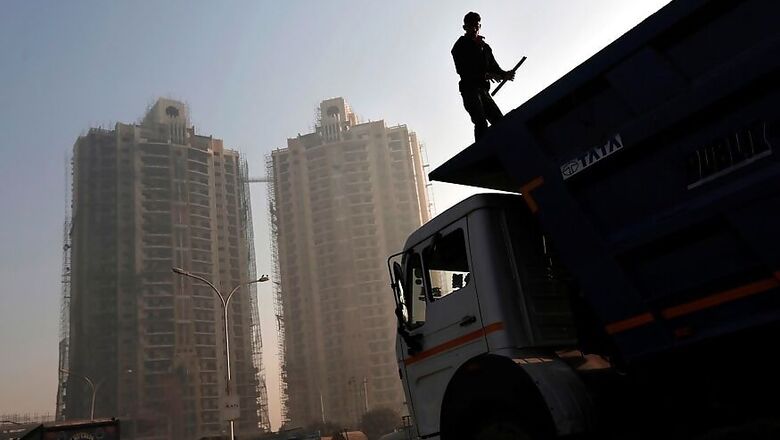
views
New Delhi: The economic fallout of the Covid-19 pandemic and the exacerbation caused by repeated, harsh lockdowns in India is much worse than thought earlier. It is already evident that the widespread loss of livelihoods across most sectors of the economy is de rigueur; so is the uncertainty surrounding a vaccine or other solutions to this deadly virus, thereby prolonging the pain.
The latest forecasts paint a rather bleak picture of the economy even as the government and the RBI keep shying away from providing any accurate reading of the situation. Global forecasters have now begun amending their earlier assessments to lower growth forecasts further for India even as the deadline for yet another possible extension of lockdown looms, even as Covid-19 infections continue to rise.
An analysis by ratings agency Crisil says that India is witnessing its worst ever recession since Independence and instead of the positive growth number the agency had put forth earlier, 2020-21 could see the economy shrink by five per cent. Analysts at the State Bank of India (SBI) say the current quarter (April-June) could see an unprecedented 40% decline in GDP and just two states (Maharashtra and Tamil Nadu) could account for a fourth of the total loss in growth this fiscal.
Global ratings agency Fitch has lowered its global GDP forecast for 2020 to (-) 4.6% from (-) 3.9% earlier, to reflect further cuts in growth estimates for some countries as also the growing health crises in Brazil, Russia and India. Fitch has also pegged GDP decline for India at five per cent this fiscal. And Goldman Sachs has revised its earlier forecast of (-)20% GDP growth in the current quarter versus the January-March period. It now says the degrowth will be a whopping 45%.
Crisil and Fitch seem to agree that the biggest reason for such an unprecedented downward revision in India’s growth forecasts, within a span of a month, is a harsh lockdown imposed by the government. India has been under a lockdown since March 24 which has lead to a near collapse in all economic activity. Now, though the government has allowed a graded opening up of businesses, there seems to be no calibrated exit strategy from such a long lockdown as infections continue to rise, India’s health infrastructure remains overwhelmed and the economy slides further.
Just one example of the mess that such a graded but unstructured lifting of lockdown has brought on: resumption of domestic flights on Monday (May 25) saw nearly one in two cancelled and hundreds of passengers were left to fend for themselves. With different states following different protocols on quarantine and opening up airports for flights, only one in six flights took off or landed across the country compared to the pre-lockdown daily average.
Such chaos is also evident across factories which are working with drastically reduced staff strength and still grappling with myriad logistical challenges; the near collapse of public transport across India’s major cities; and markets continuing to wear a deserted look.
Fitch says in a note that “The biggest revision by far (in growth forecasts) has been for India, where the virus outbreak has prompted a very severe lockdown that has lasted much longer than expected”. And Crisil has termed the lockdown in India the most stringent in the world, using data from a study by the University of Oxford (Blavatnik School of Government) to show that India scored 99 out of 100 in ‘Government Response Stringency Index’ with its harsh lockdown enforcement in April.
“Counting lockdown 4.0, Indians have had 68 days of confinement. S&P Global estimates that one month of lockdown shaves three per cent of annual GDP on average across Asia-Pacific. Since India’s lockdown has been the most stringent in Asia, the impact on economic growth will be correspondingly larger”. And the State Bank of India has referred to total Gross State Domestic Product (GSDP) loss of a whopping Rs 30.3 lakh crore due to the long lockdown.
As the country grapples with momentous economic challenges, there seems to be continued reluctance on the part of the government to offer any meaningful fiscal relief. A fiscal stimulus package was announced earlier this month, where the government claimed it had infused more than Rs 20 lakh crore or nearly 10% of the country’s GDP. But the relief may not be more than 2% of the GDP as most measures were medium to long term reforms, with little immediate fiscal implication.
So will the economy rebound (despite the near absence of fiscal stimulus and no timeline for the virus effect to lessen)? If yes, by when? Analysts say growth has tanked so badly in the ongoing quarter that it is bound to revive from such lows in the next (July-September), partly due to the abysmally low base effect. And may even begin spurting in the successive quarters. But till then, the economy needs support.
Finance Minister Nirmala Sitharaman has indicated in interviews last week that the government is open to providing more fiscal stimulus to help the economy but there is no clarity on whether this will happen and if it does, in what form.
From all available indications and macro economic data, a second round of stimulus is not just the need of the hour, it could be critical to sustain even the lowered economic contraction forecasts.
The spread of the virus remains unpredictable and an extended lockdown has already had a detrimental effect on the economy. While the RBI has done its bit to provide a large monetary stimulus, the need for a larger fiscal stimulus has not abated. According to Goldman Sachs, “While macroeconomic policies have clearly eased and we expect them to ease further...we believe that policy support, in particular discretionary fiscal policy support (defined as direct support to households and businesses) which can minimize second-round effects of the pandemic, and make any economy quickly rebound in times of an unprecedented shock, has been tepid so far.” Has the time come for large doses of direct cash transfers? Perhaps it has.




















Comments
0 comment